UPS AND DOWNS AND UPS WITH CHESTNUTS
The Best of Them, No More
Of all species of chestnuts, none is finer than the American chestnut. This majestic tree towered to 100 feet high in America’s virgin forests and yielded a wood that was used in musical instruments, molding, fenceposts, barrel staves, even telephone poles. The nuts of American chestnut are deliciously sweet and flavorful. Or, so I have read and been told, having never tasted one myself.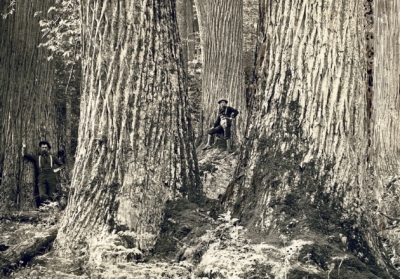
But the sturdy chestnut had its Achille’s heel — chestnut blight. The disease, accidentally introduced from Asia, was first noted at New York’s Bronx Zoo in 1906. It spread 25 to 50 miles a year and within 50 years had left 7 million acres of Appalachian forests with dead or dying chestnut trees.
The American chestnut is not gone, though. Trees cling tenaciously to life. I’ve often come upon the trees on hikes, mostly spindly reminders of once-great chestnut forests. Their roots, immune to blight, persist in sending up new sprouts as older trunks are killed back. The sprouts provide a constant source of nourishment to sustain the chestnut blight organism.
No need to write off chestnut as a lingering, dying tree, though. Looking across the Pacific to Asia, home of the blight organism, we find chestnut species with resistance to chestnut blight: Japanese Chestnut (Castaneae crenata) and Chinese chestnut (C. mollisima). Neither of these species take on the majestic, upright grandeur of the American species. Their nuts are tasty but — again, I have learned second-hand — are no match in flavor to our native chestnuts
Colossal Failure
As you might have guessed, the two Asiatic species have been hybridized with the American one to produce trees with almost the grandeur of the American chestnut, yet resistance to chestnut blight. Both species also infuse hybrids with larger, more visually attractive nuts than the pure American species.
Twenty-five years ago I purchased and planted eight hybrid varieties, some with Japanese and others with Chinese chestnut parents. What was I thinking, planting so many trees for home use? One tree provides plenty. (Two are needed for cross-pollination but the trees are wind-pollinated so a nearby wild or cultivated tree could be a suitable mate.)
Two problems arose. The first was that pollen from a variety with Chinese parentage will cause black staining of the nutmeat of a variety with Japanese parentage.
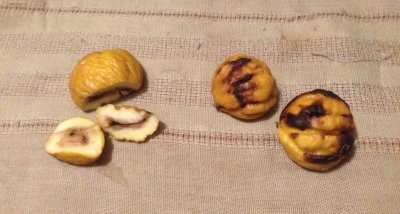
Staining of Japanese chestnuts (such as Colossal)
Too bad, because Colossal, the favorite of my trees, was a Japanese hybrid.
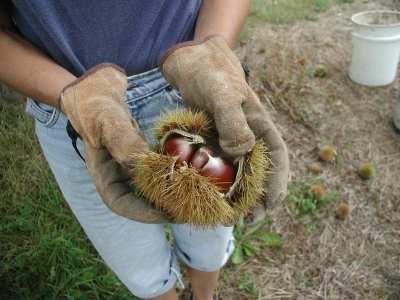
Nuts of Colossal chestnut
My option was to cut down all my Chinese hybrids, which didn’t cause me anguish because by the time I learned about staining I also learned that I had planted too many chestnut trees.
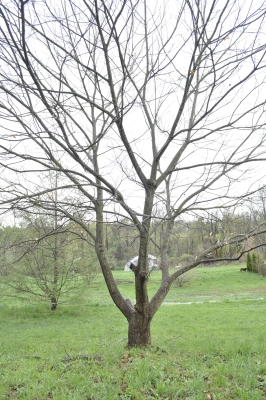
One of my seedling Chinese chestnuts
Colossal also highlighted the second problem, chestnut blight. All the varieties I had planted were resistant to blight, not immune. I guess Colossal was less resistant, and a few years ago I saw the first signs of blight. Dieback became worse each year until, after about four years, with heavy heart and empty (of chestnuts) stomach, I did what I had to do, so now only the foot and a half wide stump remains.
A couple of years ago I noticed blight on another of my large-nutted, Japanese hybrids, Marigoule.
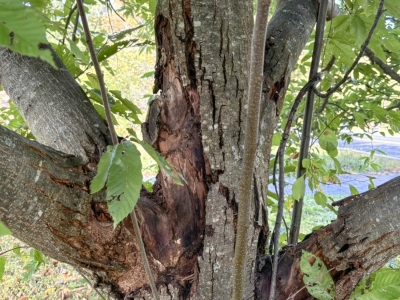
Blight on Marigoule
That tree is evidently more resistant than Colossal because now, four years after I noticed its first blighted limb, it still looks pretty healthy and this year, once again, the spreading limbs have yielded more large nuts than we can possibly eat.
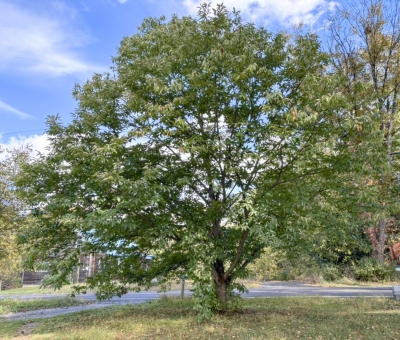
Marigoule, yesterday
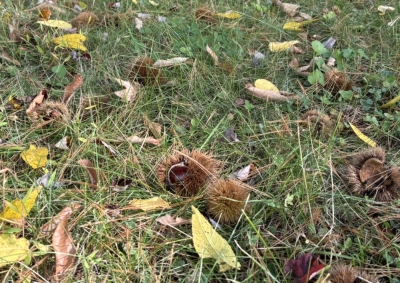
The Future is Nuts
Some nostalgic folks still long for purebred, unadulterated American chestnuts. Fortunately for them, researchers have found that the blight fungus has problems of its own; it’s susceptible to a virus (CHV1). Chestnut trees can live happily with a little blight infection, if the blight fungus has a virus. Natural spread of the virus has been effective in arresting blight spread in Europe. Here in America, though, we are dealing with a different chestnut species, a different climate, and different strains of blight and blight viruses. Over here this technique has met with partial success thus far.
Other research has shown that disease lesions on already-infected trees can be treated with “natural medication.” One scientist found that if the soil at the base of a blight-infected tree is made into a poultice and affixed to the lesion with plastic wrap and tape, the lesion heals. Remember that chestnut roots are not attacked by the blight fungus. The roots are perhaps protected from infection by certain beneficial soil microorganisms, and these same organisms might have beneficial effect when applied to infected bark.
The chestnut can return as a backyard tree, as a stately tree to line farm driveways or streets, and perhaps as a forest tree through the combined efforts of plant breeders, plant pathologists, and the observant eyes of everyday people. Perhaps an American chestnut tree towers in solitude in some forest today, awaiting discovery. Persons interested in bringing back the American chestnut are invited to join the American Chestnut Foundation (www.tacf.org).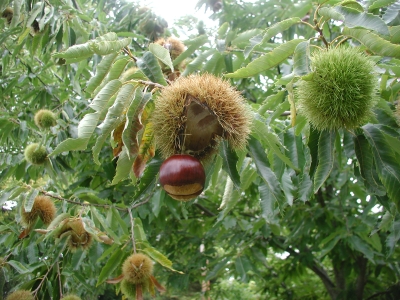
People are still fiddling around with chestnut genetics in hope of building better American chestnuts as they were or with other species or by incorporation of resistant genes to make transgenic plants.
For the present, consider planting Chinese-American or Chinese chestnut trees. Given reasonably good soil, such trees grow rapidly to eventually become forty-foot “spreading chestnut trees.” Expect the first crop in about five years from seedling plants, in two years from grafted plants.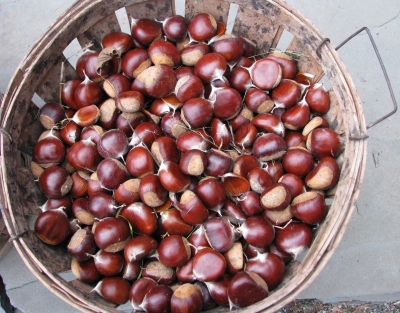



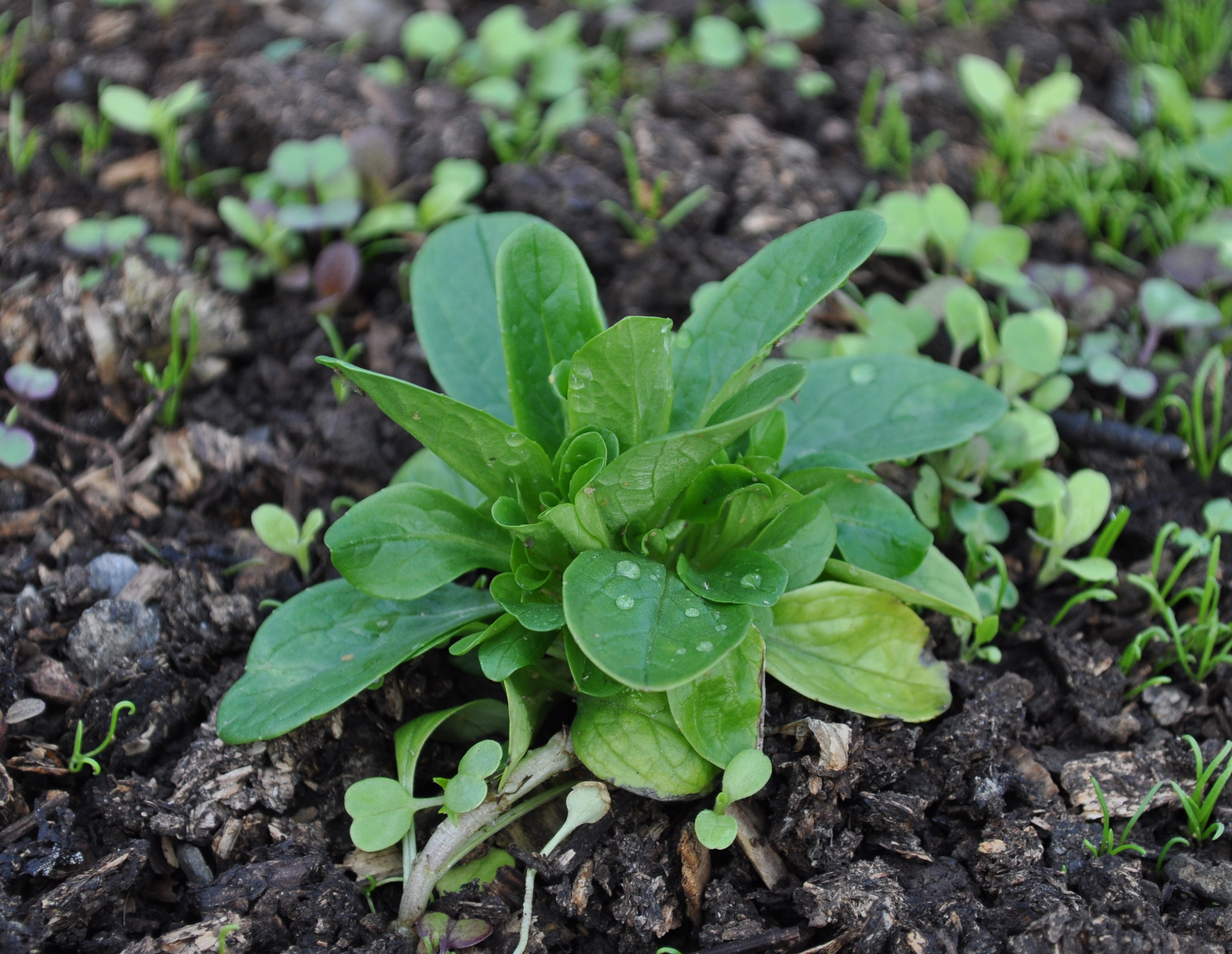
l came across the native chestnut in a clear cut here in West Virginia in a clear cut 30 years ago.first thing I noticed was the burrs on thdid ddground opened with nuts inside. I picked them up, gave them to my father, his comment was where in devil did you find theses. the tree was already cracking up from ground about 18 in. he ate them like candy.made him remember his youth. this the down fall of world trade.look what we lose.
Thank goodness for the Darling Trees. There is finally a path forward with the real American Chestnut Tree not a new hybrid species.
Just to clarify for those unfamiliar with Darling chestnuts, “Darling 58 (D58) is an American chestnut that has been genetically modified via the insertion of a gene (OxO) from wheat into the tree’s genome. The oxalate oxidase (OxO) gene degrades oxalic acid, a toxin produced by the chestnut blight fungus (Cryphonectria parasitica) as an important weapon in its attack on chestnut trees.” TACF.org supported this work through a donation from former TACF board chair Herb Darling. TACF.org subsequently withdrew support of the work because of “a number of corroborating deficiencies and concerns, including inconsistent blight resistance, a negative impact on growth, and decreased survival rates.” Also, because it was proposed to commercialize the plants, which would be contrary to the goals of TACF.org.
For a more indepth look at the transgenic chestnut breeding program was explored in a recent New York Magazine article linked here: https://nymag.com/intelligencer/article/darling-58-american-chestnut-tree-mistake.html
Thanks for the link. Very interesting details.
Thank you for this update, much appreciated. I can remember the American Chestnut on my Grandfatehers wood lot and the fledging sprouts which persist to this day. Grandmother would grind the dried nut for flour for hot cakes. We all had high hoes for the Michigan and NewYork cultivars and hope somehow more funding will become available to continue research. Perhaps with the advent of AI more progress will provide answers especially with the advent of “new asiatic” blights desciminating the Red Oak, Ash, Black Walnut and other North American gifts from the Creator.
The blight survives on alternate hosts, oak trees, which are not affected!
Yes, with chestnut species being the most vulnerable.